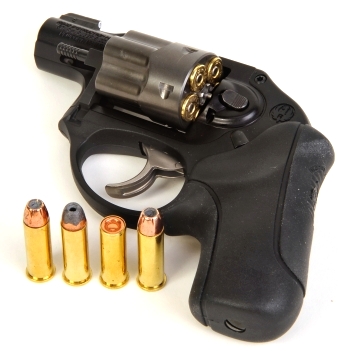
My extensive shooting experience with a snub nose revolver had been with a S&W Model 37 Airweight, and the results have always been abysmal. My hope, in a defensive situation, was that the gun’s muzzle blast would stun the perpetrator and give me enough time to find a baseball bat so I could effectively defend myself. After squeezing off a few shots with the Ruger LCR, and realizing I could hit with the gun on a regular basis, it became obvious that my Louisville Slugger’s days were numbered.
All that remained to be seen was if, in controllable form, the .38 Special was indeed really something special, or if it was just a 357 Magnum’s laid back and shorter older brother, trying to impress everyone with a lot of noise and muzzle flash.
Are three Rugers at the range a Thruger?
Rather than a comparison within a collection of similar firearms chambered for the .38 Special, it seemed better to place the gun in context by bracketing its performance with firearms a step up and a step down in ballistic performance. Both the Ruger GP100 .357 Magnum and Ruger LCP 380 ACP are shot with some frequency at RealGuns, so they were a natural choice for this part of the project. The GP100 was used to collect 4″ barrel 38 Special data as the 4″ barrel 38 Special Astra I intended to use had been inexplicably dissolved in a rust bluing mishap. But that’s another story…
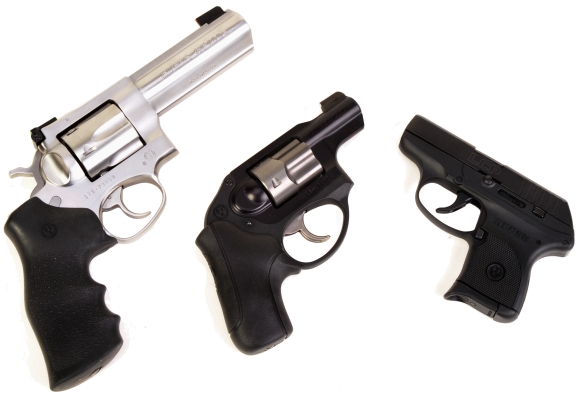
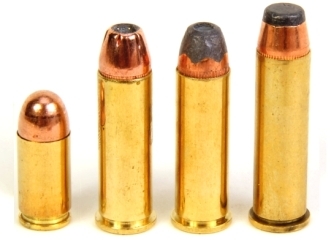 PMC Bronze ammunition was the standard used for both the .380 ACP and .357 Magnum. The .380 ACP FMJ load was selected because it feeds through the little autoloader without a hitch and hollow point loads don’t really expand to a greater size on impact. The .357 Magnum soft point was selected because that is typically what is in the gun when it is carried in the woods while hunting or out on the lake when fishing.
PMC Bronze ammunition was the standard used for both the .380 ACP and .357 Magnum. The .380 ACP FMJ load was selected because it feeds through the little autoloader without a hitch and hollow point loads don’t really expand to a greater size on impact. The .357 Magnum soft point was selected because that is typically what is in the gun when it is carried in the woods while hunting or out on the lake when fishing.
The loads that went into the Ruger LCR were +P loads handloads, with the exception of the wad cutter loads which were standard pressure .38 Special. Even at standard .38 Special pressure levels the wad cutters are not exactly light loads, as the Berry product has a recommended velocity of 800 fps for best accuracy. Not such an easy deal from a gun with an under 2″ barrel, but then wad cutters aren’t standard fare for a snub nose.
| .38 Special Handloads | ||||||||
|
Bullet |
Weight Grains |
COL | Powder | Charge Grains +P |
MV FPS 1.88″ |
MV FPS 4.00″ |
Long/ Short Δ |
7 Yard 5 Shot Group “ |
| Hornady HP/XTP | 110 | 1.450 | Power Pistol | *6.0 | 760 | 941 | 19% | 1.3 |
| Hornady HP/XTP | 110 | 1.450 | Power Pistol | 8.0 | 987 | 1227 | 20% | 1.4 |
| Remington SJHP | 125 | 1.450 | Power Pistol | 7.1 | 924 | 1090 | 15% | 1.2 |
| Berry Wad Cutter | 148 | 1.145 | Power Pistol | 4.5 | 741 | 852 | 13% | 1.1 |
| Hornady FP/XTP | 158 | 1.450 | Power Pistol | 6.0 | 780 | 937 | 17% | 1.2 |
|
CCI 500 Small Pistol Primers. * Standard Pressure Load. |
||||||||
Hmmm… 50% barrel reduction, a bit more counting the 0.030″ shorter .38 Special cylinder, but under 20% drop in velocity. The performance change is not unlike the difference between a 5″ and 3.5″ .45 ACP autoloader. The 125 grain load seemed to be the best balance of velocity, penetration and expansion.

| Cartridge | Bullet Weight |
Type | Penetration |
| 380 ACP | 90 | FMJ | 8″ |
| 38 Special | 110 | JHP | 7″ |
| 38 Special | 125 | JHP | 9“ |
| 357 Magnum | 158 | JSP | 12″ |
Shooting into ballistic medium produced some surprising results, at least surprising to me… and probably to the medium. The little .380 ACP with hardball ammo penetrated 8″ of medium. The more heavily loaded .38 Special 110 grain Hornady jacketed hollow point loads penetrated 1″ less than the .380 ACP, neither bullet expanded. The .38 Special 125 grain hollow point delivered 9″ of penetration and expanded reliably to 0.500″ – 0.600″ while retaining full weight. The .357 Magnum penetrated 12″ and expanded to 0.480″ – 0.500″ which isn’t too shabby for a 75 year old cartridge.
On target. No barn broad sides required…
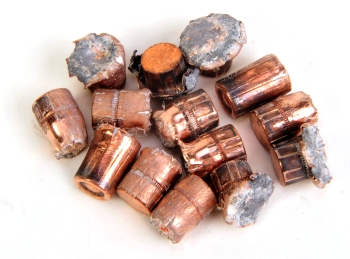 More time was spent shooting the Ruger LCR than planned. There was no hand stinging under recoil or deafening muzzle blast. The gun was flexible in digesting various types of ammo and within a small group of people, everyone was having a good time with a little recreational target shooting.
More time was spent shooting the Ruger LCR than planned. There was no hand stinging under recoil or deafening muzzle blast. The gun was flexible in digesting various types of ammo and within a small group of people, everyone was having a good time with a little recreational target shooting.
A five gallon pail full of construction sand between the target and backstop was enough to contain all of the bullets fired. Duct tape served to cover the holes as group holes began to overlap. Two pails will collect even magnum rifle bullets.
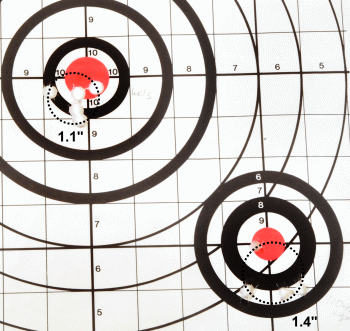
The group sizes for each specific bullet is noted on the handload table above, however, they all looked about like this.
Shooting was done at 7 yards, a combat point and shoot distance and one that covers 90% of defensive shooting circumstances.
The gun was controllable. Most of the difficulty found in shooting this gun was of course related to the very short sight radius and subsequent critical sight alignment. The best shot placement was accomplished with the top half of the front sight radius peeking up over the frame notch and this was a much more natural point than my earlier attempts the front sight buried in the frame notch.
Just about actual size at 1920×1080…
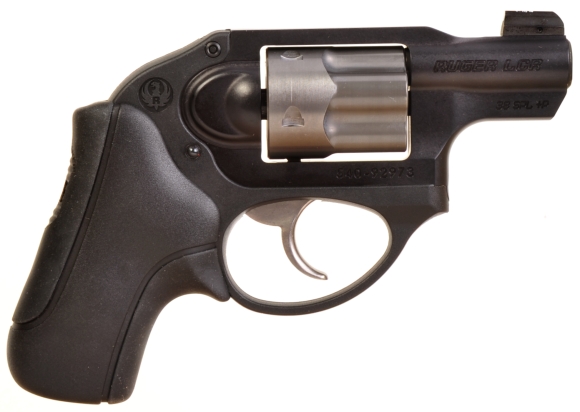
The Ruger LCR left me with a positive impression of what could be expected of a well executed .38 Special snub nose revolver. I didn’t miss the hammer as much as I thought I would, and came to appreciate the workable trigger pull and the no snag contour of the gun’s frame. It took a bit getting use to the gun’s very light weight. It felt… different. But after shooting it a bit, and carrying it around, the light weight mostly showed itself as a convenient the absence of a feel of dead weight hanging from my belt.
The finish is durable and wipes off easily with even light solvents and cleaners. The grip, while small in dimension to keep the gun inside of a compact envelope, is hand filling through four fingers and it provides a cushioned support beneath the grip for the pinky. The trigger guard loop is large enough to not get in the way. The Tritium sight is OK, but personally I’d like a bright HiViz light pipe sight that would really be easy to pick out in even dim lighting. I have a set of HiViz sights on my personal GP100 and they are terrific. Again, personal preference as the Ruger LCR will be a point and shoot proposition for most owners, but then the front sight is pinned which opens up a lot of options.
The 38 Special has enough… stuff, to get the job done while not being abusive or expensive to shoot. It out classes the .380 ACP and serves well where a .357 Magnum is not needed. I am sure the Ruger LCR is, or will, be the solution for concealed carry or open carry where bulk and weight is a concern. It is as good at what it does as the GP100 and little LCP for their specific applications. Great little gun.
There are currently four models of the LCR, including the KLCR-357 which is a .357 Magnum version. Others include a model with Crimson Trace laser grips and a base model with Hogue® Tamer™ grips and a plain ramped front sight.
Ruger’s LCR – LCR-BGXS Part I
Ruger’s LCR – LCR-BGXS Part II

Email Notification